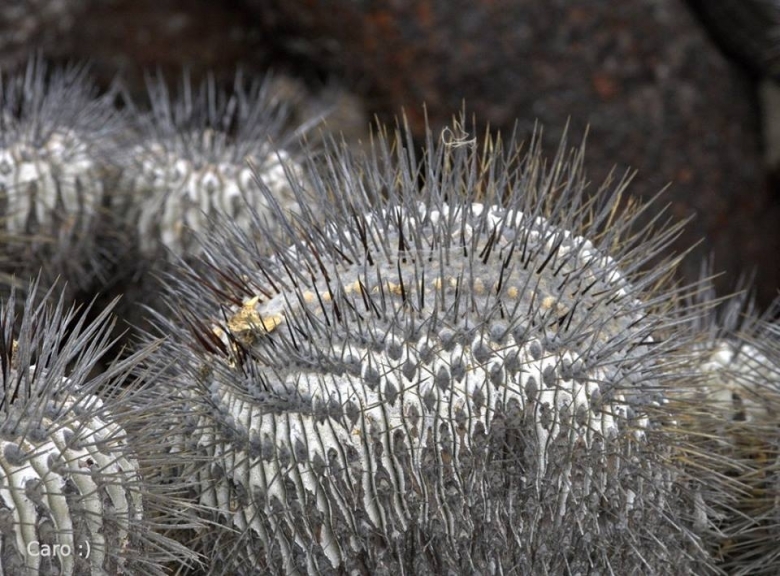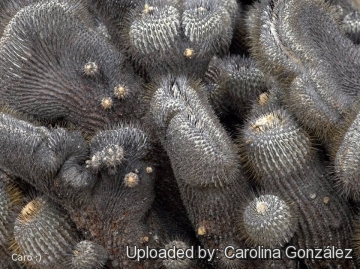Accepted Scientific Name: Copiapoa malletiana
Kaktus-ABC [Backeb. & Knuth] 280. 1936 [12 Feb 1936]

Copiapoa dealbata f. cristata Photo by: Carolina González
Crested habit at Huasco, 03 Atacama, Chile.
Origin and Habitat: A very few crested specimens of C. dealbata occurs among normal plants along the Chilean coast, both north and south of Carrizal Bajo, and at a point ca halfway towards Totoral, Atacama, Chile. It has a restricted range (extent of occurrence 500 km2), however the species is abundant, there is no continuing decline of the populations.
Altitude: (0–)20-500(-700) metres above sea level.
Habitat: C. dealbata is locally abundant forming groups of several individuals near the coast, in coastal hills (lomas costeras) in a very dry area on sandy alluvial and rocky soils, and desert shrubland on sandy soil. Despite the lack of rain where it lives, the extreme aridity is attenuated by the frequent, often dense, coastal fogs. It shows a recurrent pattern; usually it is overcast in the early mornings, the clouds dissipating during the late morning and returning during the late afternoons. At times this region is dominated by geophytes, which can cover expanses of the desert spectacularly. The species is sporadically collected for ornamental use, only a small portion of the plant is taken and this is not lethal. The major threats are off-road vehicles and road construction.
Synonyms:
See all synonyms of Copiapoa malletiana
back
Accepted name in llifle Database:Copiapoa malletiana (Lem. ex Salm-Dyck) Backeb. in Backeb. & F.M.KnuthKaktus-ABC [Backeb. & Knuth] 280. 1936 [12 Feb 1936]Synonymy: 10
back
Description: The typical Copiapoa dealbata is a cespitose, greyish-white globular cactus typically with only one single spine from the areoles. The form with more spine per arela (up to 7) is known as Copiapoa carrizalensens but the two forms grows side by side and plants with few or more spines grows together in the same population.
Crested form: The crested forms are cultivated for their beautiful stem with dense bristly spine and pronounced sculpture effects. These plants produce crests, and crests occasionally produce normal shoots. Flowers are produced both on the the apex of normal and crested specimens. The plants are often grafted on stronger species, called the stock, that can be any number of different columnar cactus.
Bibliography: Major references and further lectures
1) A. Gomez Sanchez “Enciclopedia ilustrada de los cactus y otras suculentas” Mundi-Prensa Libros, 2006
2) Cactus & Succulent Journal of Great Britain 43: 59 1981
3) Riha & Subik. “The illustrated encyclopedia of cacti and other succulents” (edited by G. & K.A. Beckett) 1981
4) James Cullen, Sabina G. Knees, H. Suzanne Cubey “The European Garden Flora Flowering Plants: A Manual for the Identification of Plants Cultivated in Europe, Both Out-of-Doors and Under Glass” Cambridge University Press, 11/ago/2011
5) Clive Innes “Complete Handbook of Cacti and Succulents” Van Nostrand Reinhold Company, 01/Dec/1981
6) Stephen D. Davis, Vernon Hilton Heywood, Alan Charles Hamilton, International Union for Conservation of Nature and Natural Resources “Centres of Plant Diversity: The Americas” World Wide Fund for Nature (WWF) and ICUN - World Conservation Union, 1994
7) Edward Anderson “The Cactus family” Timber Press, Incorporated, 2001
8) David R Hunt; Nigel P Taylor; Graham Charles; International Cactaceae Systematics Group. "The New Cactus Lexicon" dh books, 2006
9) N. L. Britton, J. N. Rose “The Cactaceae. Descriptions and Illustrations of Plants of the Cactus Family.” Volume 4, The Carnegie Institution of Washington, Washington 1923
10) Faundez, L., Walter, H.E. & Saldivia, P. 2013. Copiapoa dealbata. The IUCN Red List of Threatened Species 2013: e.T152929A696219. http://dx.doi.org/10.2305/IUCN.UK.2013-1.RLTS.T152929A696219.en. Downloaded on 18 February 2016.
 Crested habit at Huasco, 03 Atacama, Chile. Photo by: Carolina González
Crested habit at Huasco, 03 Atacama, Chile. Photo by: Carolina GonzálezSend a photo of this plant.The gallery now contains thousands of pictures, however it is possible to do even more. We are, of course, seeking photos of species not yet shown in the gallery but not only that, we are also looking for better pictures than those already present.
Read More... Cultivation and Propagation: Copiapoa dealbata f. cristataSN|32527]]SN|32527]] will tolerate sun and heat, but not extended periods of frost. The crested form is more frost sensitive and should not be kept at less than -5°C. Grow them in rich, porous, sandy soil, and let their soil dry out between waterings. If potted, repot in the spring, if their roots become cramped. Generally, they should be repotted every other year in order to provide fresh soil. However, this doesn't necessarily mean they'll need larger containers. Fill about a quarter of the pot with broken crocks, gravel, etc. to promote good drainage. After repotting, do not water for a week or more. The crested plants enjoy a warm sunny environment and for more speedy growth a light position on a higher shelf with light feeding and rainwater given to the bottom of the plant will ensure success, especially with rooted detached branches, which do well in these conditions.
Propagation: Grafting. It can also be increased by cuttings, which will take root in a minimum temperature of 20° C. Cuttings of healthy shoots can be taken in the spring and summer. Cut the stem with a sharp, sterile knife, leave the cutting in a warm, dry place for a week or weeks (depending on how thick the cutting is) until a callus forms over the wound. Once the callus forms, the cutting may be inserted in a container filled with firmed cactus potting mix topped with a surface layer of coarse grit. They should be placed in the coarse grit only; this prevents the cut end from becoming too wet and allows the roots to penetrate the rich compost underneath. The cuttings should root in 2 to 6 weeks.











